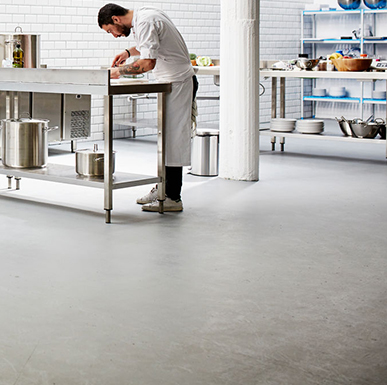Technical Bulletin No. 1
The correct surface preparation is essential to the successful installation of tiles or coatings and toppings. All dust, dirt, oil, grease, form release agents, curing compounds and laitance must be removed. (Laitance is the weak, powdery layer of hardened cement, which often appears at the surface of new concrete).
Generally, the thinner the coating the more attention must be paid to the surface preparation, as thinner coatings pass higher loads to the substrate-coating interface, and of course a thinner coating has less physical strength to resist loads/impacts by itself than a thicker coating.
Preparation techniques include the following:
A. Mechanical
Abrasive Blasting: Projects abrasive or metal particles of varying size at the surface at high velocity. Can incorporate vacuum extraction (captive blasting).
Mechanical Impact (Scabbling or Scarifying): Roughens surface with a tool having several points tipped with tungsten or similar, that will pulverize or fracture the surface.
High Pressure Water: Roughens surface by projecting high-pressure jets of water. Abrasive media is sometimes introduced into the water.
Grinding: Roughens surface by abrading with a diamond encrusted disc.
B. Chemical
Chemical Cleaning: Removes oil, grease, etc., from surface. Note: does not roughen surface.
Acid Etching: Roughens surface and removes laitance by reacting with hardened cement paste, and exposing fine aggregate. Metz seldom reommends acid etching due to environmental issues, risk to neighbouring surfaces, the difficulty in achieving consistent results and the need to thoroughly rinse away all acid residues.
The preparation technique or techniques used depend on the condition of the concrete surface and the type of coating, which is to be applied.
Oil and grease cannot normally be removed by abrasive means only. Surface contaminants must first be removed by chemical cleaning. (For example, a strong caustic cleaner.) Then the surface can be roughened by the methods previously described. If oil or grease has deeply penetrated the concrete, the surface must be removed by mechanical means until a clean, profiled surface is obtained.
Abrasive blasting is generally the minimum surface preparation required. A light blast removes laitance and exposes the top surfaces of the fine aggregates. This would be suitable for self-leveling type coatings and membranes. A heavier blast, which exposes some pieces of coarse aggregate, may be more suitable for 6mm trowel applied toppings.
Always inspect the floor closely after the surface preparation is completed. If applying a coating, all holes and cracks in the concrete surface should be filled. The surface must be clean and have a textured surface. If any chemical agents have been used they must be completely removed prior to any installation.
Before applying Metz tiling or toppings or coating systems, the concrete surface should be tested for moisture content and surface strength. Consult Metz for details of test methods.
Metz General Recommendations:
Consult Metz technical data sheets (TDS) for further details or contact Metz.
I. New Concrete:
Generally, at least a light abrasive blast is required. Captive blasting will minimize dust. In some cases (e.g. for membranes or thin coatings), a high pressure water blast is adequate. Note, however that all laitance must be removed.
II. Old Concrete:
Sound – Chemically clean if required. Captive abrasive blast to clean surface.
Damaged (e.g. acid attacked) – Scabble or scarify to remove all damaged concrete and provide a sound surface. Check pH of surface. Neutralise if necessary.
Oil or Grease Impregnated – Scabble or scarify to remove concrete until oil/grease free surface is obtained. Chemically clean new surface, if necessary to remove any traces of oil or grease.
Notes:
A strong caustic cleaner is efficient at removing oil, grease and other contaminants from concrete.
Metz does not normally recommend acid etching because of inconsistent results.
Any cracks in the concrete must be carefully treated. Consult Metz.



